After a painfully long absence from Nintendo's home consoles, Intelligent Systems is finally ready to unleash Fire Emblem on unsuspecting GameCube owners. Why should GameCube fans be so excited? Let me tell you a few things about this beauty.
It's been six years since Fire Emblem Thracia 776 was released on the Super Famicom (yep, in Japan SNES games were still being produced at the turn of the century) and a lot has changed since that late sprite-based classic. GameCube Fire Emblem is the first 3D overhaul of the series. That alone should be enough to have most Fire Emblem followers in a state of frenzy.
The opening sequence of Fire Emblem shows the world of Tellius being plagued by all sorts of conflicts (sounds like Earth, eh?) while a beautiful princess rests in a large castle. Ike (a major game protagonist) then rides a galloping Epona-like horse through dark forests in a bid to gather an army that can stop all the fighting once and for all. It's mightily impressive and thorough cinematic -- in fact, Fire Emblem shares some visual likenesses with the forthcoming GameCube Zelda game. That can only be a good thing!
Memorable characters provide one of the Fire Emblem's greatest charms. Ike and Tiamat are the GameCube version's lead characters, but hundreds of other minor players will join your army along the journey. Each squad member has unique personal data, and as that character plays an ever greater role in your army, it's inevitable that you'll get real chummy. Because no two are exactly alike, there's a good chance of forging an affinity with any character, but as in most Emblem games, when characters die they stay dead. Perhaps the sense of loss we experience here is what real emotion in games is all about.
There is a deep story running through Fire Emblem, leading to the eventual downfall of the trouble-making Daein kingdom, but most of your time will be spent in battles or preparing for them. As ever, these are of the turn-based variety. Encounters in Fire Emblem are similar to those of Shining Force, with characters placed on squares and a grid drawn over the terrain. Some battle areas are huge, taking in whole villages, which makes Fire Emblem feel like a true epic.






